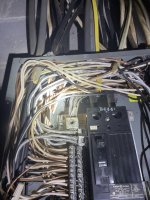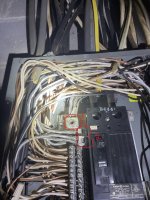phonedave
Well-known member
- May 30, 2012
- 2,232
- Pool Size
- 17000
- Surface
- Vinyl
- Chlorine
- Salt Water Generator
- SWG Type
- Hayward Turbo Cell (T-CELL-5)
I'm no electrician either, but I have personally encountered a problem which was solved by moving a white neutral wire from the ground bus to the neutral bus. I had a GFCI breaker which kept tripping. Opening the panel revealed the misplaced neutral wire (installed by my PB's "electrician"). Moving it to the neutral bus solved the problem 100%.
So in my ignorance, I believe that voltage differential can be present even when my mental model says different wires should be at the same potential.
Neutrals and grounds are bonded in the main service entrance panel. They should not be bonded anywhere else.
New panels have a ground bus bar and a neutral bus bar, but if you look in the main panel the two busses are bonded together. In any sub-panel the neutral and ground busses are not connected (bonded)
They are bonded at the main panel, because you need a way to clear a fault. If your ground becomes energized, it will be bonded to the neutral and return the electricity to the transformer, and trip the breaker.
What happens if you bond them at a sub panel is that electricity is going to go where physics dictates it should go. Simplistically, you have power coming in on the hot leg, and returning on the neutral leg, and nothing on the ground. But if you bond that ground to a neutral at the subpanel, it may easier for electricity to "go back" on the neutral to the sub panel, and then instead of staying on the neutral back to the transformer, it might be easier for it to go on the ground to somewhere else - like a pool.
If you only bond them at the main panel, you know that the return electricity is going to go back on the neutral the entire way, and your grounds will not have voltage on them.



